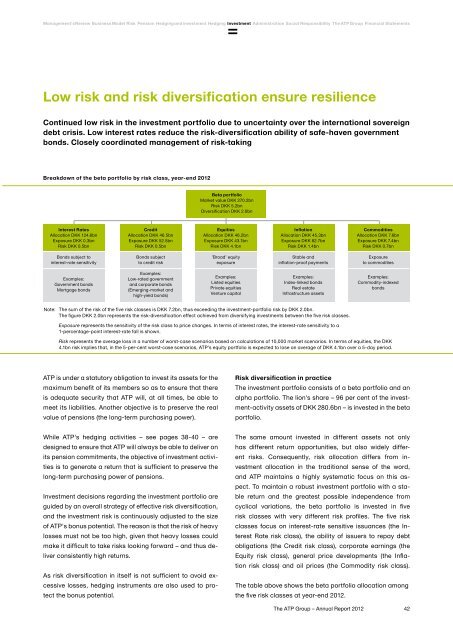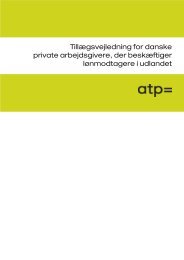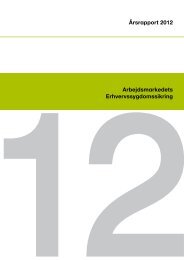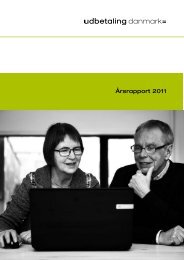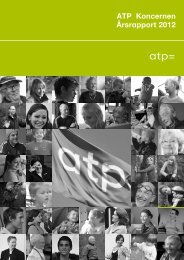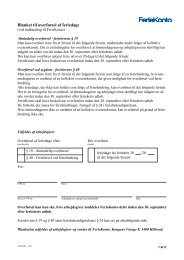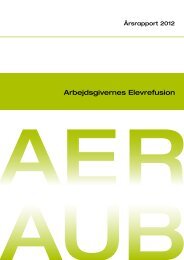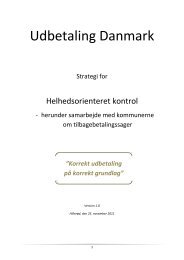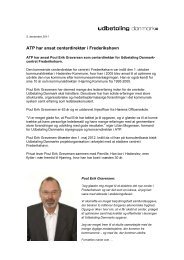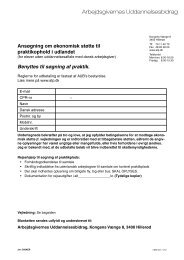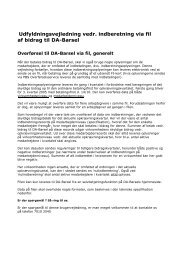The ATP Group Annual Report 2012
The ATP Group Annual Report 2012
The ATP Group Annual Report 2012
Create successful ePaper yourself
Turn your PDF publications into a flip-book with our unique Google optimized e-Paper software.
Management's Review Business Model Risk Pension Hedging and investment Hedging Investment Administration Social Responsibility <strong>The</strong> <strong>ATP</strong> <strong>Group</strong> Financial StatementsLow risk and risk diversification ensure resilienceContinued low risk in the investment portfolio due to uncertainty over the international sovereigndebt crisis. Low interest rates reduce the risk-diversification ability of safe-haven governmentbonds. Closely coordinated management of risk-takingBreakdown of the beta portfolio by risk class, year-end <strong>2012</strong>Beta portfolioMarket value DKK 270.2bnRisk DKK 5.2bnDiversification DKK 2.0bnInterest RatesAllocation DKK 124.6bnExposure DKK 0.3bnRisk DKK 0.5bnCreditAllocation DKK 46.5bnExposure DKK 52.5bnRisk DKK 0.5bnEquitiesAllocation DKK 46.2bnExposure DKK 43.1bnRisk DKK 4.1bnInflationAllocation DKK 45.3bnExposure DKK 82.7bnRisk DKK 1.4bnCommoditiesAllocation DKK 7.6bnExposure DKK 7.4bnRisk DKK 0.7bnBonds subject tointerest-rate sensitivityBonds subjectto credit risk’Broad’ equityexposureStable andinflation-proof paymentsExposureto commoditiesExamples:Government bondsMortgage bondsExamples:Low-rated governmentand corporate bonds(Emerging-market andhigh-yield bonds)Examples:Listed equitiesPrivate equitiesVenture capitalExamples:Index-linked bondsReal estateInfrastructure assetsExamples:Commodity-indexedbondsNote: <strong>The</strong> sum of the risk of the five risk classes is DKK 7.2bn, thus exceeding the investment-portfolio risk by DKK 2.0bn.<strong>The</strong> figure DKK 2.0bn represents the risk-diversification effect achieved from diversifying investments between the five risk classes.Exposure represents the sensitivity of the risk class to price changes. In terms of interest rates, the interest-rate sensitivity to a1-percentage-point interest-rate fall is shown.Risk represents the average loss in a number of worst-case scenarios based on calculations of 10,000 market scenarios. In terms of equities, the DKK4.1bn risk implies that, in the 5-per-cent worst-case scenarios, <strong>ATP</strong>’s equity portfolio is expected to lose an average of DKK 4.1bn over a 5-day period.<strong>ATP</strong> is under a statutory obligation to invest its assets for themaximum benefit of its members so as to ensure that thereis adequate security that <strong>ATP</strong> will, at all times, be able tomeet its liabilities. Another objective is to preserve the realvalue of pensions (the long-term purchasing power).Risk diversification in practice<strong>The</strong> investment portfolio consists of a beta portfolio and analpha portfolio. <strong>The</strong> lion's share – 96 per cent of the investment-activityassets of DKK 280.6bn – is invested in the betaportfolio.While <strong>ATP</strong>'s hedging activities – see pages 38-40 – aredesigned to ensure that <strong>ATP</strong> will always be able to deliver onits pension commitments, the objective of investment activitiesis to generate a return that is sufficient to preserve thelong-term purchasing power of pensions.Investment decisions regarding the investment portfolio areguided by an overall strategy of effective risk diversification,and the investment risk is continuously adjusted to the sizeof <strong>ATP</strong>'s bonus potential. <strong>The</strong> reason is that the risk of heavylosses must not be too high, given that heavy losses couldmake it difficult to take risks looking forward – and thus deliverconsistently high returns.As risk diversification in itself is not sufficient to avoid excessivelosses, hedging instruments are also used to protectthe bonus potential.<strong>The</strong> same amount invested in different assets not onlyhas different return opportunities, but also widely differentrisks. Consequently, risk allocation differs from investmentallocation in the traditional sense of the word,and <strong>ATP</strong> maintains a highly systematic focus on this aspect.To maintain a robust investment portfolio with a stablereturn and the greatest possible independence fromcyclical variations, the beta portfolio is invested in fiverisk classes with very different risk profiles. <strong>The</strong> five riskclasses focus on interest-rate sensitive issuances (the InterestRate risk class), the ability of issuers to repay debtobligations (the Credit risk class), corporate earnings (theEquity risk class), general price developments (the Inflationrisk class) and oil prices (the Commodity risk class).<strong>The</strong> table above shows the beta portfolio allocation amongthe five risk classes at year-end <strong>2012</strong>.<strong>The</strong> <strong>ATP</strong> <strong>Group</strong> – <strong>Annual</strong> <strong>Report</strong> <strong>2012</strong>42


